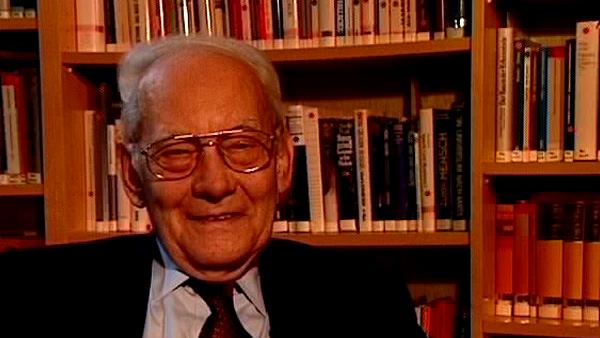NEXT STORY

Nature finds a way not to calculate everything in detail
RELATED STORIES

NEXT STORY

Nature finds a way not to calculate everything in detail
RELATED STORIES


|
Views | Duration | |
|---|---|---|---|
| 51. A nice story about quasispecies | 223 | 01:06 | |
| 52. Günther Strunk's true evolution experiment | 186 | 03:08 | |
| 53. Nature finds a way not to calculate everything in detail | 151 | 05:53 | |
| 54. A chance meeting with Francis Crick in Mainz | 233 | 01:02 | |
| 55. What does a hypercycle do? | 355 | 03:42 | |
| 56. Proving the hypercycle system | 181 | 03:49 | |
| 57. The Hypercycle - A Principle of Natural... | 1 | 265 | 01:12 |
| 58. No theory without experiments, no experiments without theory | 389 | 04:40 | |
| 59. The necessity for the theory for hypercycles | 161 | 01:46 | |
| 60. Einstein and the theory of quantum mechanics | 334 | 01:45 |


Let me tell you a little bit about a true evolution experiment and you will ask why do you do... why do you make experiments when you know the mechanisms... all well...? You cannot calculate what is the product of evolution. It's so complicate, and I will tell you a story of an experiment we did here. It was done by a student... the experimental work was done by a student in his PhD thesis, Günther Strunk. It had to use a machine because the replication time in this... we optimised our conditions so that the total replication of an RNA strength took less than a minute. So everything had to go with the machine controlled and we used Spiegelman's technique of serial transfer.
[Q] But maybe you should... who built the machine? I remember these were doctoral theses, diploma work, so they must have...
Oh yes, it was an electrical engineer who did a doctor thesis in electrical engineering here, Hajo Otten, and then other people worked together with him. Günter Bauer worked on that machine, and finally Günter Strunk and Rolf Günther... ja, he did the latest...
[Q] ... more sophisticated...
... more sophisticated parallel machines. Now let me explain this machine. The reaction vessel is a little silver plate, it has a little deepening which takes up a few microlitre of substance. Now, first surprise, our enzyme didn't like silver, like certain ladies prefer gold over silver - so did our enzyme. We had to make a gold inlet in order to persuade the enzyme to work, but that it did beautifully in the gold vessel. Why did we take silver plate? Well I said you let it grow then you stop the reaction, take a tenth out of it, let it grow, stop the reaction. And we start and stop the reaction by a temperature jump. We simply put the silver plate, if it is not growing at 0°C, and when it is supposed to grow it is pushed on to a metal block which is 37°C or above 30°C... then in a second it assumes that temperature, starts to grow. We watch it with a laser over a glass fibre optics. The laser measures the fluorescence of these samples. The fluorescence tells us about the amount of RNA produced. And when a certain amount was produced we stopped the reaction, take an aliquot out and start the next series... and Günther Strunk did this experiment.
Nobel Prize winning German biophysical chemist, Manfred Eigen (1927-2019), was best known for his work on fast chemical reactions and his development of ways to accurately measure these reactions down to the nearest billionth of a second. He published over 100 papers with topics ranging from hydrogen bridges of nucleic acids to the storage of information in the central nervous system.
Title: Günther Strunk's true evolution experiment
Listeners: Ruthild Winkler-Oswatitch
Ruthild Winkler-Oswatitsch is the eldest daughter of the Austrian physicist Klaus Osatitsch, an internationally renowned expert in gas dynamics, and his wife Hedwig Oswatitsch-Klabinus. She was born in the German university town of Göttingen where her father worked at the Kaiser Wilhelm Institute of Aerodynamics under Ludwig Prandtl. After World War II she was educated in Stockholm, Sweden, where her father was then a research scientist and lecturer at the Royal Institute of Technology.
In 1961 Ruthild Winkler-Oswatitsch enrolled in Chemistry at the Technical University of Vienna where she received her PhD in 1969 with a dissertation on "Fast complex reactions of alkali ions with biological membrane carriers". The experimental work for her thesis was carried out at the Max Planck Institute for Physical Chemistry in Göttingen under Manfred Eigen.
From 1971 to the present Ruthild Winkler-Oswatitsch has been working as a research scientist at the Max Planck Institute in Göttingen in the Department of Chemical Kinetics which is headed by Manfred Eigen. Her interest was first focused on an application of relaxation techniques to the study of fast biological reactions. Thereafter, she engaged in theoretical studies on molecular evolution and developed game models for representing the underlying chemical proceses. Together with Manfred Eigen she wrote the widely noted book, "Laws of the Game" (Alfred A. Knopf Inc. 1981 and Princeton University Press, 1993). Her more recent studies were concerned with comparative sequence analysis of nucleic acids in order to find out the age of the genetic code and the time course of the early evolution of life. For the last decade she has been successfully establishing industrial applications in the field of evolutionary biotechnology.
Tags: Evolution experiments, serial transfer, Günther Strunk, Sol Spiegelman, Hajo Otten, Günter Bauer, Rolf Günther
Duration: 3 minutes, 9 seconds
Date story recorded: July 1997
Date story went live: 24 January 2008